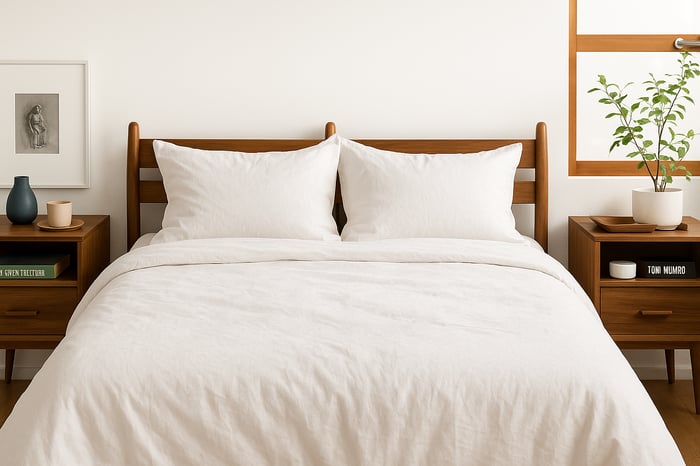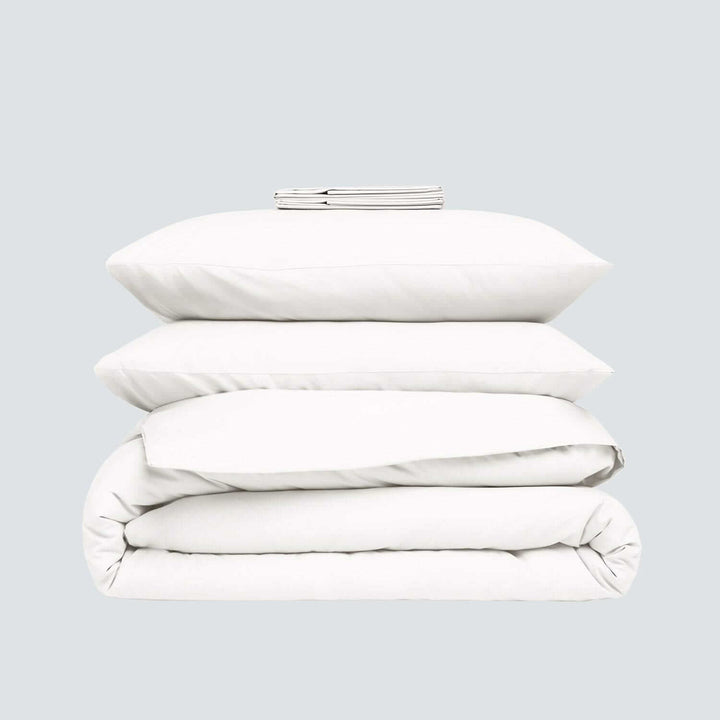Table of Contents
- When Sleep Feels Like a Sauna
- The Science of Sleep Temperature
- Ranking Criteria
- 🥇 1. Wool — Nature’s Cooling Powerhouse
- 🥈 2. Linen — The Breathable Classic
- 🥉 3. Organic Cotton — The Everyday Essential
- 🧵 4. Bamboo Viscose — Soft, but Misleadingly “Cool”
- 5. Silk — Smooth, but Suffocating
- 6. Polyester and Microfiber — The Heat Trap
- Side-by-Side Comparison: Best Bedding Materials for Hot Sleepers
- The Sleep Science Verdict
- Building a Cooling Sleep System
- Why Regenerative Wool Leads the Pack
- Cooler Sleep, Naturally
- FAQs on Wool Duvet Inserts, Comforters & Sustainable Bedding
When Sleep Feels Like a Sauna
If you’re tired of waking up drenched, the secret isn’t colder air conditioning — it’s choosing the right bedding materials for hot sleepers that actually let your body breathe. You’re part of the 1 in 3 adults who qualify as hot sleepers — people whose bodies retain or generate more heat during rest.
But the problem isn’t always you — it’s often your bedding. Synthetic fabrics, dense weaves, and plush fillings trap body heat, forcing your body to fight its natural temperature regulation process.
The secret isn’t just in thread count or brand names. It’s in material science—specifically, how fibers handle breathability, moisture management, and temperature regulation.
In this guide, we’ll rank the best bedding materials for hot sleepers, based on research into thermoregulation, airflow, and sustainability. From natural fibers like wool and cotton to synthetics like polyester and bamboo viscose, here’s what science—and sleep—has to say.
 Naturally cool and effortlessly calm. The best bedding materials for hot sleepers combine organic fibers and airflow to keep you comfortable all night long.
Naturally cool and effortlessly calm. The best bedding materials for hot sleepers combine organic fibers and airflow to keep you comfortable all night long.The Science of Sleep Temperature
Our bodies naturally cool down before and during sleep. Core temperature drops about 1–2°F, helping the body transition into deep sleep. When bedding traps heat and humidity, this cooling process is disrupted—causing night sweats, tossing, and shallow sleep.
Three key factors decide how “cool” bedding feels:
Thermal conductivity – how fast heat moves through fabric.
Moisture-wicking capacity – how efficiently sweat evaporates.
Air permeability – how well air circulates through the weave.
The ideal bedding for hot sleepers allows the body to maintain its natural rhythm: releasing excess heat, absorbing moisture vapor, and preventing clamminess.
If you’re looking for cooler, drier nights, explore our Hot Sleepers Collection for breathable, moisture-wicking bedding.
Organic Wool Duvet Insert & Bedding Set | Sustainable & Regenerative | Made in New Zealand

$475.15
$559.00
Cooler Nights & Deeper Sleep — All Year Long Looking for the perfect organic wool duvet insert and wool bedding set? This complete bundle includes both the duvet insert and cover. (The insert uses the same breathable, temperature-regulating design as… Read more
Ranking Criteria
To rank the best bedding materials for hot sleepers, we evaluated each based on:
| Factor | Description |
|---|---|
| Breathability | Ability to let air pass through |
| Moisture Management | How well it wicks and evaporates sweat |
| Thermal Regulation | How well it balances warmth and coolness |
| Sustainability | Environmental impact and renewability |
| Comfort & Longevity | Softness, durability, and real-world performance |
Now, let’s look at how the most common bedding materials perform—ranked from best to worst for hot sleepers.
🥇 1. Wool — Nature’s Cooling Powerhouse
Best for: Year-round comfort and hot sleepers who sweat easily.
Wool might seem counterintuitive—it’s known for warmth—but its genius lies in adaptive temperature regulation. The crimped fibers in wool create tiny air pockets that trap cool air when it’s hot and insulate when it’s cold.
Scientific edge:
Wool can absorb up to 30% of its weight in moisture without feeling damp.
Its natural lanolin repels odor-causing bacteria.
The structure promotes constant airflow, keeping humidity low.
Why it tops the list:
Regenerative New Zealand wool, like the kind used in Antipodean Home’s comforters, maintains perfect microclimate control—cooler when you need it, warmer when you don’t. It’s also biodegradable and farmed to restore soil health.
Organic Wool Comforter | Made in New Zealand, Breathable All-Season Comfort

$342.00
$380.00
Sleep naturally better with our organic wool comforter Unlike down or synthetic comforters that trap heat, our spun wool design wicks away moisture and prevents overheating, so you stay cool & dry. Designed for deeper sleep with a gentle weight… Read more
🥈 2. Linen — The Breathable Classic
Best for: Hot, humid climates and minimalist sleepers.
Linen, made from flax, has exceptional airflow due to its looser weave and natural fiber thickness. It absorbs moisture quickly and dries fast—key for managing night sweats.
Science says:
Linen conducts heat five times better than wool and 18 times better than silk.
It becomes softer with every wash, maintaining structure for decades.
Drawback: It wrinkles easily and can feel crisp at first, but that’s a small trade-off for its cooling power.
🥉 3. Organic Cotton — The Everyday Essential
Best for: Universal comfort, especially for sensitive skin.
Organic cotton sheets strike a balance between softness, breathability, and moisture control. An optimal thread count of 300–400 allows air to circulate freely while maintaining a smooth texture.
Science says:
Cotton fibers naturally expand and contract with humidity, helping regulate airflow.
Organic cotton avoids chemical coatings that block breathability.
Why it’s great:
Cotton is highly versatile and pairs beautifully with wool comforters for balanced cooling from top to bottom.
If you’re looking for our full range of regenerative, organic bedding, explore our complete collection for everything you need to build a naturally healthier sleep sanctuary.
🧵 4. Bamboo Viscose — Soft, but Misleadingly “Cool”
Best for: Those wanting silky feel with moderate breathability.
Bamboo viscose often gets marketed as eco-friendly and cooling, but science tells a mixed story. It’s chemically processed cellulose, meaning airflow and temperature control depend on the manufacturing method.
Science says:
Bamboo’s moisture management is decent, but it’s less breathable than linen or cotton.
Chemical processing removes much of the plant’s natural structure, reducing airflow.
Verdict: Feels soft, but can trap heat under dense weaves. Choose only certified closed-loop production to avoid harsh chemicals.
5. Silk — Smooth, but Suffocating
Best for: Occasional use, not chronic overheating.
Silk feels luxurious but performs poorly for hot sleepers. It’s a dense fiber with minimal air channels. Once you begin to sweat, it clings.
Science says:
Silk absorbs up to 10% of its weight in moisture, far less than wool or cotton.
Low air permeability leads to heat buildup.
Verdict: Fine for aesthetics or pillowcases, not for temperature-regulating bedding.
6. Polyester and Microfiber — The Heat Trap
Best for: Budget-conscious shoppers (but not for comfort).
Polyester fibers are derived from petroleum, meaning they’re non-breathable and moisture-repelling. Sweat has nowhere to go, leading to overheating and that clammy “synthetic” feel.
Science says:
Polyester retains 80% more heat than cotton under identical conditions.
No natural wicking mechanism—creates a microclimate of trapped humidity.
Verdict: Affordable but counterproductive. Great for camping gear, not your sleep sanctuary.
If you’re looking for gentle, irritation-free comfort, see our Hypoallergenic Collection made for sensitive sleepers.
Side-by-Side Comparison: Best Bedding Materials for Hot Sleepers
| Rank | Material | Breathability | Moisture Wicking | Temperature Regulation | Sustainability |
|---|---|---|---|---|---|
| 🥇 1 | Wool | Excellent | Excellent | Excellent | Regenerative |
| 🥈 2 | Linen | Excellent | Excellent | High | Renewable |
| 🥉 3 | Organic Cotton | High | Good | High | Certified Organic |
| 4 | Bamboo Viscose | Moderate | Good | Moderate | Chemically processed |
| 5 | Silk | Low | Low | Low | Non-renewable |
| 6 | Polyester / Microfiber | Poor | Poor | Poor | Non-renewable |
The Sleep Science Verdict
From a scientific standpoint, breathability and moisture management matter more than thread count or fabric softness.
Natural fibers like regenerative wool, linen, and organic cotton allow for continuous heat exchange and vapor release, creating a stable microclimate for sleep. Synthetics like polyester and microfiber block airflow, forcing the body to compensate by sweating more.
Key takeaway:
If you often overheat, your body isn’t the problem—your bedding is. Switching to breathable, natural bedding materials for hot sleepers can reduce night sweats by up to 50%, according to multiple thermoregulation studies.
Sustainable & Regenerative Bedding Bundle | No More Night Sweats, Just Deeper Sleep

$598.40
$748.00
Cooler Nights & Deeper Sleep — Every Night Elevate your sleep with the only sustainable bundle crafted from regenerative New Zealand wool and organic cotton for true all-season comfort. These breathable, eco-friendly fibers naturally wick away heat and moisture to… Read more
Building a Cooling Sleep System
No single fabric can fix overheating — layering the right bedding materials for hot sleepers is the real key to cooler, balanced sleep. Start with breathable sheets: Organic cotton or linen (thread count 300–400).
Add a cooling comforter: Regenerative wool offers lightweight insulation and moisture balance.
Top with a duvet cover: Choose organic cotton for airflow.
Skip synthetics: Even “cool-touch” polyester fabrics trap heat.
This combination works like climate control for your bed—balancing airflow, insulation, and comfort all night long.
Why Regenerative Wool Leads the Pack
Unlike conventional wool, regenerative wool comes from farms that restore soil health and biodiversity. Scientifically, this wool also performs better: cleaner fiber structure, fewer impurities, and stronger natural crimp for superior airflow.
At Antipodean Home, our wool is ZQ-certified—traceable, humane, and responsibly grown across 3.7 million acres of regenerative farmland in New Zealand.
So when you sleep under a wool comforter for hot sleepers, you’re not only staying cool—you’re participating in the planet’s regeneration cycle.
Cooler Sleep, Naturally
Science has spoken: the best bedding for hot sleepers is natural, breathable, and sustainable. Materials like wool, linen, and organic cotton outperform synthetics in every measurable way — temperature balance, moisture control, and environmental impact.
If you’re ready to stop sweating through the night, choose bedding that breathes. Because when your sleep stays cool, your mornings get brighter. Discover Our Naturally Breathable Bedding for Hot Sleepers
FAQs on Wool Duvet Inserts, Comforters & Sustainable Bedding
What’s the coolest bedding material scientifically?
Regenerative wool and linen outperform others due to superior airflow and moisture vapor control.
Are bamboo sheets good for hot sleepers?
They’re softer than cotton but less breathable. Choose organic cotton or wool for lasting temperature regulation.
How do I know if my bedding is breathable?
Look for natural fibers and mid-range thread counts (300–400). If it feels dense or silky-slick, it probably traps heat.
Is wool bedding itchy or heavy?
No. Modern wool bedding is ultra-soft and lightweight, thanks to Airlay or cluster-spun designs that increase airflow.
Can breathable bedding really stop night sweats?
Yes — breathable materials wick moisture before it turns to sweat, helping the body stay in its natural cool cycle.




